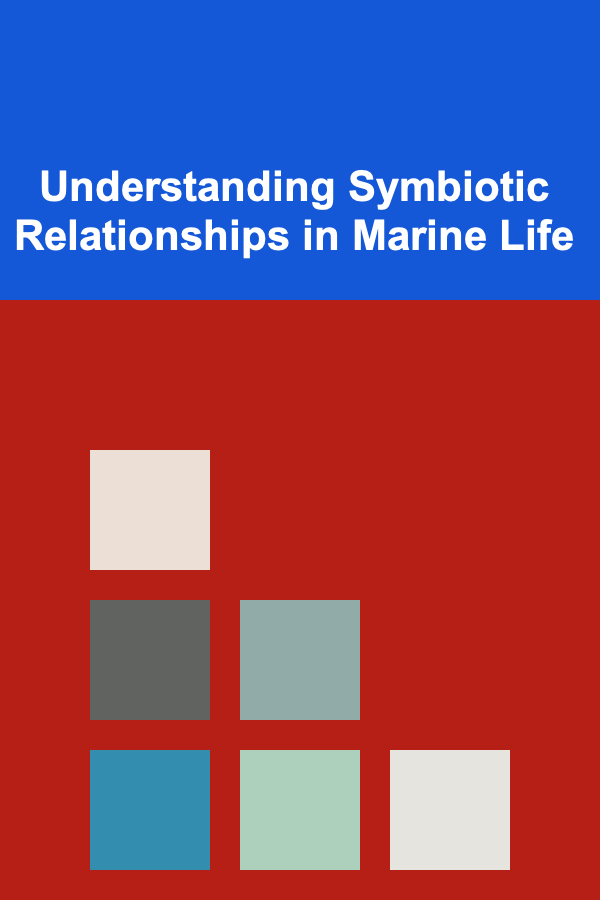
Understanding Symbiotic Relationships in Marine Life
ebook include PDF & Audio bundle (Micro Guide)
$12.99$10.99
Limited Time Offer! Order within the next:

The ocean, a vast and largely unexplored realm, teems with life in a complex and interconnected web. One of the most fascinating aspects of marine ecology is the prevalence of symbiotic relationships. Symbiosis, derived from the Greek word meaning "living together," describes any type of close and long-term biological interaction between two different biological organisms, be it mutualistic, commensalistic, or parasitic. Understanding these relationships is crucial not only for appreciating the intricate beauty of marine ecosystems but also for effectively conserving them in the face of increasing environmental pressures.
Defining and Differentiating Symbiotic Relationships
Before delving into specific examples, it's essential to establish a clear understanding of the different types of symbiosis. The three main categories, often viewed as endpoints on a spectrum, are:
- Mutualism: A relationship where both organisms involved benefit. This is often considered the most harmonious form of symbiosis.
- Commensalism: A relationship where one organism benefits, and the other is neither harmed nor helped significantly. The neutral impact on one partner is the defining characteristic.
- Parasitism: A relationship where one organism (the parasite) benefits at the expense of the other (the host). This can range from causing minor inconvenience to debilitating or even fatal consequences for the host.
It's important to remember that these categories aren't always rigid and absolute. A relationship that appears to be commensalistic at first glance might, upon closer examination, reveal subtle benefits or detriments to one or both parties. Furthermore, the nature of a symbiotic relationship can evolve over time or under different environmental conditions, shifting from mutualistic to parasitic or vice versa. The key is to focus on the net impact on each organism involved.
Mutualistic Relationships in the Marine Environment
Mutualism is arguably the most readily apparent and celebrated type of symbiosis, as it showcases the collaborative spirit of nature. The marine environment offers a plethora of captivating examples:
Coral and Zooxanthellae: The Foundation of Coral Reefs
Perhaps the most iconic example of marine mutualism is the relationship between reef-building corals and microscopic algae called zooxanthellae. These algae reside within the coral tissue, providing the coral with up to 90% of its energy through photosynthesis. The zooxanthellae use sunlight to convert carbon dioxide and water into sugars, which the coral then utilizes for growth, reproduction, and skeletal formation. In return, the coral provides the zooxanthellae with a protected environment and access to essential nutrients, such as nitrogen and phosphorus, which are scarce in nutrient-poor tropical waters. This partnership is fundamental to the existence of coral reefs, some of the most biodiverse ecosystems on Earth.
Coral bleaching, a phenomenon triggered by rising ocean temperatures or pollution, disrupts this delicate relationship. When stressed, corals expel the zooxanthellae, causing them to lose their vibrant color and, more importantly, their primary source of energy. If the stress persists, the coral will eventually starve and die. The widespread coral bleaching events occurring globally serve as a stark reminder of the vulnerability of mutualistic relationships to environmental change.
Clownfish and Sea Anemones: A Shield and a Scavenger
The vibrant clownfish and the stinging sea anemone form another well-known mutualistic partnership. Clownfish, unlike most other fish, are immune to the anemone's stinging tentacles due to a layer of mucus on their skin. They live within the anemone's tentacles, gaining protection from predators who are deterred by the stings. In return, the clownfish provides several benefits to the anemone. They keep the anemone clean by consuming algae and parasites, they provide aeration by fanning their fins, and their waste products provide nutrients. Some clownfish also actively defend the anemone from anemone-eating fish. This reciprocal exchange highlights the intricate co-evolution that can occur between species.
Cleaner Fish and Their Clients: A Mobile Cleaning Service
Many species of cleaner fish, such as the cleaner wrasse, engage in a mutualistic relationship with larger fish. These small fish establish cleaning stations on reefs, where larger fish, known as clients, come to have parasites and dead tissue removed. The cleaner fish benefit by obtaining a reliable food source, while the clients benefit by being freed from irritating and potentially harmful parasites. This interaction is so important that some clients will even alter their behavior to signal their intention to be cleaned, such as opening their mouths wide or holding their fins out. Interestingly, some fish mimic the appearance and behavior of cleaner wrasse to trick larger fish, but instead of cleaning, they take a bite out of the client's skin, a clear example of parasitic mimicry that exploits the established mutualistic relationship.
The Gut Microbiome of Marine Animals: Internal Alliances
Similar to terrestrial animals, many marine animals rely on complex communities of microorganisms residing in their digestive systems to aid in digestion and nutrient absorption. This is particularly true for herbivores, such as sea turtles and marine iguanas, who feed on tough, fibrous plant matter. The microorganisms, including bacteria and archaea, break down cellulose and other complex carbohydrates that the host animal cannot digest on its own. In return, the host provides the microorganisms with a stable environment and a constant supply of food. The importance of this gut microbiome is increasingly recognized as scientists uncover the diverse roles these microorganisms play in the health and well-being of marine animals.
Sea turtles, for example, depend on their gut microbiome to process the tough seagrasses and algae they consume. Changes in the gut microbiome, due to pollution or antibiotics, can severely impact the turtle's ability to digest food, leading to malnutrition and weakened immunity.
Commensalistic Relationships: One Benefits, the Other is Neutral
Commensalism represents a less overtly reciprocal form of symbiosis, where one organism benefits, while the other is neither significantly harmed nor helped. While seemingly straightforward, identifying true commensalistic relationships can be challenging, as subtle benefits or costs to the seemingly unaffected organism may be overlooked.
Remoras and Sharks: Hitchhikers of the Sea
Remoras are fish equipped with a modified dorsal fin that functions as a suction cup, allowing them to attach themselves to larger marine animals, such as sharks, whales, and sea turtles. Remoras benefit from this association by gaining transportation, protection from predators, and access to leftover food scraps from the host's meals. The host, on the other hand, is generally unaffected by the presence of the remora. While some argue that remoras might occasionally remove parasites from the host, suggesting a mutualistic element, the primary benefit appears to be one-sided.
Barnacles and Whales: Filter Feeders on the Move
Barnacles are crustaceans that attach themselves to hard surfaces, including rocks, ships, and even the skin of whales. Barnacles benefit from attaching to whales by gaining access to nutrient-rich waters as the whale migrates through different regions of the ocean. They also benefit from the whale's movement, which helps them filter feed more efficiently. The whale, in most cases, is not significantly affected by the presence of the barnacles. While a heavy infestation of barnacles might slightly increase drag and energy expenditure for the whale, the overall impact is generally considered negligible. However, localized infestations around sensitive areas, such as the blowhole, could potentially have negative consequences, blurring the line between commensalism and parasitism.
Pearlfish and Sea Cucumbers: Inquiline Tenants
Some species of pearlfish exhibit commensalistic behavior by residing within the bodies of sea cucumbers. The pearlfish enters the sea cucumber through its anus and lives inside its respiratory tree. The pearlfish benefits from this arrangement by gaining shelter from predators and a stable environment. The sea cucumber, in theory, is not significantly affected by the presence of the pearlfish. However, if the pearlfish consumes the sea cucumber's gonads or other internal organs, the relationship would shift from commensalistic to parasitic.
Epiphytes on Seagrass: Light and Space
Epiphytes are organisms, typically algae and small invertebrates, that grow on the surface of plants without harming them. In seagrass beds, epiphytes attach to the seagrass blades, gaining access to sunlight and nutrients. The seagrass itself is typically not directly harmed by the presence of these epiphytes, as long as they don't become so abundant as to block sunlight or impede water flow. However, excessive epiphyte growth, often fueled by nutrient pollution, can shade the seagrass, reducing its photosynthetic capacity and leading to decline. In such cases, the relationship transitions from commensalism to a form of parasitism or competition.
Parasitic Relationships: One Benefits, the Other Suffers
Parasitism represents the exploitative side of symbiosis, where one organism benefits at the expense of the other. Parasites can range in size from microscopic bacteria to macroscopic worms and crustaceans, and they employ a variety of strategies to infect, feed on, and reproduce within their hosts. Parasitism is an incredibly common phenomenon in the marine environment, playing a significant role in regulating populations and shaping community structure.
Isopods and Fish: External Parasites
Various species of isopods, a type of crustacean, are parasitic on fish. Some isopods attach to the exterior of the fish, feeding on its blood and tissue. Others, such as the tongue-eating isopod (Cymothoa exigua), enter the fish through its gills and attach to its tongue. The isopod then feeds on the blood in the tongue, eventually causing the tongue to atrophy and fall off. The isopod then replaces the tongue, effectively becoming a functional replacement for the fish's missing organ. While the fish can still feed, it suffers from reduced food intake and increased susceptibility to infection.
Copepods and Marine Mammals: Tiny Bloodsuckers
Copepods are small crustaceans that are ubiquitous in the marine environment. Many species of copepods are parasitic on marine mammals, such as whales and dolphins. These copepods attach to the skin of the host and feed on its blood and tissue. Heavy infestations of copepods can cause irritation, inflammation, and even secondary infections in the host.
Parasitic Worms in Fish: Internal Invaders
Various species of parasitic worms, including nematodes, cestodes (tapeworms), and trematodes (flukes), infect fish. These worms can infect various organs of the fish, including the gut, liver, and muscles. Infections can cause a range of symptoms, including weight loss, reduced growth, and impaired reproduction. Some parasitic worms can also be transmitted to humans through the consumption of raw or undercooked fish.
Dinoflagellates and Shellfish: Paralytic Shellfish Poisoning
Certain species of dinoflagellates, a type of microscopic algae, produce potent toxins that can accumulate in shellfish. When humans consume shellfish contaminated with these toxins, they can suffer from paralytic shellfish poisoning (PSP), a potentially fatal condition that can cause paralysis and respiratory failure. The dinoflagellates benefit from the shellfish by gaining a protected environment and access to nutrients, while the shellfish and humans suffer from the toxic effects of the algae.
Phage and Bacteria: Viral Predators
Viruses, specifically bacteriophages (phages), play a crucial role in regulating bacterial populations in the ocean. Phages infect and kill bacteria, often in a highly specific manner. While seemingly a simple predator-prey relationship, it's a form of parasitism. The phage benefits by replicating within the host bacteria, eventually lysing the cell and releasing new phages to infect other bacteria. This constant cycle of infection and lysis shapes the composition and diversity of bacterial communities, influencing nutrient cycling and other essential processes in the marine ecosystem.
The Dynamic Nature of Symbiosis and its Importance
It's crucial to remember that symbiotic relationships are not static entities but rather dynamic interactions that can change over time and under different environmental conditions. A relationship that appears mutualistic under normal circumstances might become parasitic under stress. For example, if the ocean becomes more acidic due to increased carbon dioxide levels, the ability of coral to maintain its symbiotic relationship with zooxanthellae may be compromised, leading to coral bleaching. Similarly, a commensalistic relationship can shift towards parasitism if one of the partners becomes excessively abundant or if environmental conditions change in a way that favors one partner over the other.
Furthermore, the health of marine ecosystems is inextricably linked to the health of the symbiotic relationships that underpin them. Disruptions to these relationships, whether caused by pollution, climate change, overfishing, or other human activities, can have cascading effects throughout the food web, leading to ecosystem degradation and loss of biodiversity. Understanding the intricacies of these relationships is therefore essential for developing effective conservation strategies that protect not just individual species but the entire fabric of marine life.
Future Research and Conservation Implications
Further research is needed to fully unravel the complexities of symbiotic relationships in the marine environment. Advances in molecular techniques, such as metagenomics and transcriptomics, are providing unprecedented insights into the genetic and metabolic interactions between symbiotic partners. These tools allow scientists to identify the specific genes and biochemical pathways that are involved in symbiosis, providing a deeper understanding of the mechanisms that drive these interactions.
In addition, research is needed to understand how symbiotic relationships are affected by environmental stressors, such as climate change and pollution. This knowledge is crucial for predicting how marine ecosystems will respond to future environmental changes and for developing strategies to mitigate the negative impacts of these changes.
Effective conservation strategies must take into account the importance of symbiotic relationships. Protecting coral reefs, for example, requires not only reducing pollution and greenhouse gas emissions but also addressing the factors that contribute to coral bleaching. Similarly, managing fisheries sustainably requires understanding how fishing pressure can affect the populations of both the target species and their symbiotic partners.
By deepening our understanding of symbiotic relationships in marine life, we can gain a greater appreciation for the interconnectedness of marine ecosystems and develop more effective strategies for conserving these vital resources for future generations. The ocean's future hinges on our ability to understand and protect these intricate partnerships that shape life beneath the waves.

How to Cultivate Equanimity in All Situations
Read More
How to Declutter Your Home Before Staging
Read More
How to Profit from Deep Learning in the Business World
Read More
How to Reduce Echo in Your Home with Simple Soundproofing Tips
Read More
How to Prepare Delicious & Nutritious Smoothies
Read More
10 Tips for Creating Sturdy Flower Crowns That Last
Read MoreOther Products

How to Cultivate Equanimity in All Situations
Read More
How to Declutter Your Home Before Staging
Read More
How to Profit from Deep Learning in the Business World
Read More
How to Reduce Echo in Your Home with Simple Soundproofing Tips
Read More
How to Prepare Delicious & Nutritious Smoothies
Read More